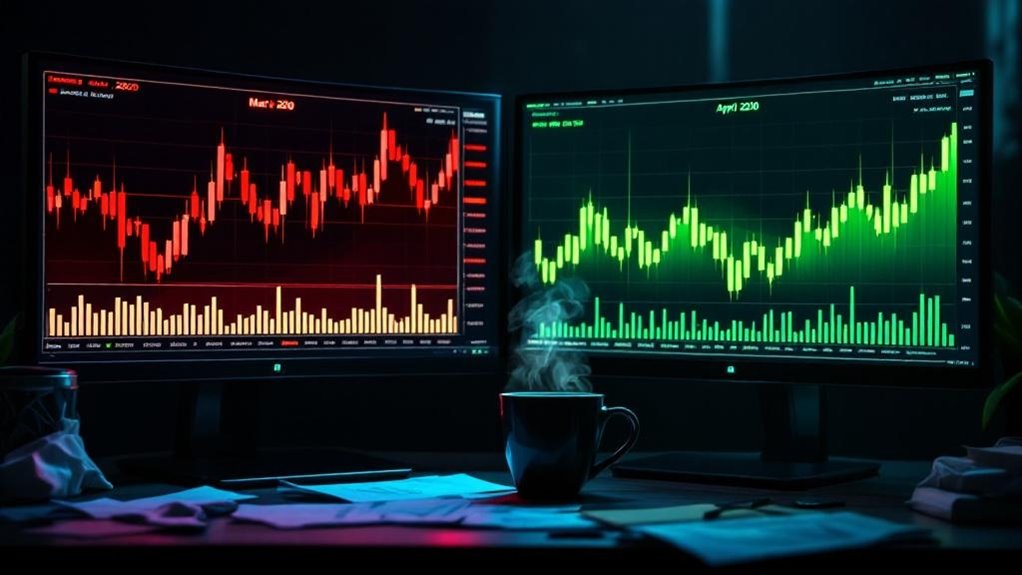Historical analysis reveals mixed results regarding market timing effectiveness. While exceptional cases like Jesse Livermore’s $100 million profit from the 1929 crash and Warren Buffett’s strategic $8 billion deployment during 2008 demonstrate rare success, empirical evidence suggests most professional timing attempts underperform passive strategies. Studies, including William Sharpe’s research, indicate a required 74% accuracy rate to match buy-and-hold returns, highlighting why even sophisticated institutional investors struggle with timing. Further examination of major market events offers critical insights into this challenging investment approach.
Key Takeaways
- Jesse Livermore successfully timed the 1929 market crash through technical analysis and market psychology, generating $100 million in profits.
- Warren Buffett’s strategic timing during the 2008 crisis yielded exceptional returns through preferred stock investments in Goldman Sachs and GE.
- Studies show professional market timers consistently underperform simple buy-and-hold strategies, requiring 74% accuracy to match passive returns.
- The 2000 Tech Bubble collapse demonstrated how warning signs like extreme valuations and insider selling can signal market turning points.
- Historical evidence indicates most institutional investors fail at market timing, with only 23% of active funds outperforming passive investments.
The Exceptional Timing of Jesse Livermore in 1929

While many investors have attempted to time market crashes throughout history, Jesse Livermore‘s prescient positioning before the 1929 Wall Street Crash stands as one of the most remarkable examples of successful market timing.
Through rigorous application of technical analysis and acute market psychology observation, he built substantial short selling positions ahead of the crash. His early experiences as a board boy in Boston helped shape his understanding of market dynamics and price movements.
Livermore’s disciplined approach yielded extraordinary results, generating approximately $100 million in profits (equivalent to $1.7 billion today) during the market’s catastrophic decline.
While his timing proved exceptional, modern research shows that buy-and-hold strategies generally produce better long-term results for most investors.
His success stemmed from unwavering adherence to established trading principles, including patient position-building and resistance to prevailing bullish sentiment.
Operating in an era of limited market information and widespread manipulation, Livermore relied on price action interpretation rather than fundamental data or insider knowledge.
His methodical execution, despite significant skepticism from contemporaries, demonstrated the potential effectiveness of contrarian market timing when supported by rigorous technical analysis and disciplined risk management.
Navigating the Tech Bubble Collapse of 2000
While seasoned investors identified warning signs of the impending tech bubble collapse through indicators like unsustainable P/E ratios and mounting margin debt levels reaching $300 billion by early 2000, many market participants remained entrenched in high-momentum growth positions.
The stark performance divergence between value and growth stocks created a pronounced market bifurcation, with the NASDAQ composite doubling between 1999-2000 while traditional value sectors remained relatively stagnant. Price-to-earnings ratios reached unprecedented levels, with many tech companies trading at 200 times earnings during the peak.
Implementing strict stop-loss orders proved crucial for protecting capital during the volatile market conditions. Those who successfully navigated the subsequent crash typically executed strategic portfolio shifts away from speculative tech names toward defensive sectors and fixed-income securities, particularly after the Federal Reserve’s series of interest rate hikes signaled a less accommodative monetary environment.
Warning Signs Emerged Early
In retrospect, the warning signs preceding the tech bubble collapse of 2000 appeared with remarkable clarity, though investors largely chose to ignore them. The manifestation of bubble warnings became increasingly evident through multiple indicators that sophisticated market participants should have recognized. Like today’s price to innovation metrics, investors in 2000 created new valuation measures to justify increasingly stretched valuations.
Sector rotation strategies could have helped investors protect their portfolios during this turbulent period.
- Insider profit-taking and institutional capital reallocation away from technology sectors signaled growing skepticism among experienced investors.
- The Federal Reserve’s successive interest rate increases in 1999-2000 deliberately aimed to reduce market speculation and excess liquidity.
- Fundamental disconnects between market valuations and profitability metrics reached unprecedented levels, with companies allocating up to 90% of budgets to marketing rather than sustainable operations.
This pattern of investor behavior, characterized by selective disregard for traditional valuation metrics, epitomized the irrational exuberance that ultimately led to the market’s dramatic correction.
Value Versus Growth Divide
The stark divide between value and growth investing strategies reached its zenith during the late 1990s tech bubble, marking one of the most dramatic philosophical battles in modern market history. This period demonstrated how market sentiment could dramatically diverge from fundamental analysis.
| Strategy | 1995-2000 Performance | Post-2000 Recovery |
|---|---|---|
| Growth Investing | +500% (Nasdaq) | -80% Decline |
| Value Investing | Underperformed | Steady Recovery |
| Market Impact | Extreme Valuations | Return to Fundamentals |
The disparity became so pronounced that even Warren Buffett’s value investing approach faced unprecedented scrutiny from financial media. While growth investing dominated headlines with astronomical returns, particularly in technology stocks, traditional value metrics were largely dismissed as obsolete. A systematic rebalancing approach could have helped investors maintain disciplined exposure during this volatile period. Today’s tech landscape shows more resilience with lower P/E ratios compared to the extreme valuations seen during the dot-com era.
The subsequent market correction ultimately validated the importance of fundamental analysis, as companies lacking strong cash flows and earnings faced severe consequences.
Strategic Portfolio Repositioning
Successfully maneuvering the dramatic technology sector collapse of 2000 required institutional and retail investors to implement systematic portfolio repositioning strategies across multiple asset classes and sectors.
The unprecedented market conditions demanded thorough risk assessment and strategic portfolio diversification to mitigate catastrophic losses. With nearly 40% of venture capital flowing into Internet companies by 1999, the need for portfolio rebalancing became increasingly urgent. Defensive sectors demonstrated their critical value as safe havens during this period of extreme market turbulence.
- Institutional funds pivoted away from speculative tech holdings toward traditional sectors, emphasizing companies with sustainable cash flows and established business models.
- Multi-asset allocation strategies incorporating bonds, real estate, and defensive sectors provided critical downside protection during the 77% Nasdaq decline.
- Systematic rebalancing and stop-loss implementation proved essential for capital preservation, particularly as the tech-heavy Nasdaq required 15 years to recover its March 2000 peak.
The aftermath reinforced fundamental principles of disciplined investing and sector rotation during extreme market dislocations.
Warren Buffett’s Strategic Moves During the 2008 Crisis
During the 2008 financial crisis, Warren Buffett’s Berkshire Hathaway demonstrated exemplary market timing by deploying substantial capital into distressed yet fundamentally sound companies like Goldman Sachs and General Electric through preferred stock arrangements yielding 10% dividends.
His methodical approach of waiting for moments of maximum uncertainty enabled highly favorable deal terms, including equity warrants and protective covenants that prioritized Berkshire’s interests.
By leveraging real-time news analysis, Buffett was able to distinguish critical market signals from general market noise to identify optimal entry points.
The strategic timing and structure of these investments, which included $5 billion in Goldman Sachs and $3 billion in GE, not only provided critical stability to the financial system but also generated significant returns through both regular dividend income and eventual profitable exits when market conditions improved. The investment proved particularly timely as Goldman Sachs received an additional $10 billion from TARP just weeks after Berkshire’s capital injection.
Crisis Creates Rare Opportunities
While global financial markets teetered on the brink of collapse in 2008, Warren Buffett’s Berkshire Hathaway executed a series of strategic investments that would later be regarded as masterful examples of crisis-era opportunity capture.
The extraordinary market conditions enabled Buffett to secure unprecedented terms from blue-chip institutions desperate for capital and confidence. Despite drawing initial public criticism, this bold move during the financial crisis would ultimately generate billions in profits for Berkshire shareholders. Like savvy investors during earnings season volatility, Buffett recognized the importance of timing market entry points during periods of extreme uncertainty.
- Berkshire’s $5 billion Goldman Sachs investment yielded 10% annual dividends plus $5 billion in equity warrants at $115 per share, exemplifying the premium terms available during peak market distress.
- The $3 billion General Electric deal replicated this model, combining preferred shares with warrants while generating an estimated $1.5 billion profit.
These crisis investing opportunities allowed Buffett to minimize downside risk through preferred shares while maintaining substantial upside potential through warrant structures.
Patient Capital Deployment Strategy
Warren Buffett’s patient capital deployment strategy during the 2008 financial crisis exemplified masterful market timing, characterized by strategic investments in blue-chip institutions when panic created unprecedented opportunities.
His strategic foresight manifested through carefully structured deals with Goldman Sachs and General Electric, securing preferred shares yielding 10% dividends plus equity warrants. GE’s acceptance of these terms came as the company faced unprecedented market weakness in its financial services division.
The deployment of patient capital focused exclusively on fundamentally sound enterprises with enduring competitive advantages, while avoiding overleveraged or structurally compromised sectors.
Berkshire’s investments featured sophisticated downside protection mechanisms, including executive share-holding requirements and favorable buyback provisions, while maintaining substantial upside potential through warrant structures.
This methodical approach to capital allocation during peak market distress ultimately generated exceptional returns through both current income and long-term appreciation potential.
Buffett’s success demonstrated the importance of combining multiple timeframes analysis with fundamental valuations to identify optimal market entry points.
Value Over Market Fear
The bedrock principle of value investing emerged with remarkable clarity through Buffett’s strategic moves during the 2008 financial crisis, showcasing how disciplined adherence to fundamentals can triumph over market hysteria.
While market psychology drove widespread panic selling, Buffett’s approach demonstrated the superiority of focusing on intrinsic business value. The rapid spread of fear in September 2008 created what many called a financial tsunami, yet this presented prime opportunities for value investors. Unlike dollar-cost averaging, Buffett’s market timing required deep analytical expertise and conviction.
- His $5 billion investment in Goldman Sachs and $3 billion in General Electric exemplified the value investing doctrine of acquiring quality assets during periods of maximum pessimism.
- By securing preferred shares with 10% dividends and favorable warrant terms, Buffett prioritized margin of safety while others fled to cash.
These strategic moves reinforced Benjamin Graham’s teachings on viewing market fluctuations as opportunities rather than threats, ultimately validating the timeless principles of value investing during extreme market conditions.
Why Professional Market Timers Often Miss the Mark
Despite decades of experience and sophisticated analytical tools, professional market timers consistently struggle to outperform simple buy-and-hold strategies across extended time horizons. The empirical evidence from S&P Dow Jones Indices’ SPIVA Scorecards demonstrates this underperformance becomes more pronounced as investment periods lengthen.
Several critical factors contribute to professional market timers’ shortcomings. Behavioral biases and emotional traps, including overconfidence and loss aversion, impair decision-making even among seasoned professionals. The risk of missing best days can devastate portfolio performance, with studies showing dramatically reduced returns when investors fail to participate in key market rebounds. Even analyzing volume price divergence can lead to false signals when attempting to time market reversals.
The challenges are further compounded by technical limitations, as information latency and algorithmic trading create insurmountable execution barriers. The cumulative impact of transaction costs, taxes, and missed opportunities presents a considerable drag on returns.
Studies by Charles Schwab reveal that immediate, long-term investment strategies consistently outperform timing attempts, while research by Barber and Odean confirms that frequent traders considerably underperform market benchmarks, highlighting the futility of professional timing endeavors.
Lessons From the 2020 Market Volatility

During unprecedented market turmoil in March 2020, global financial markets experienced extreme volatility that challenged conventional market timing strategies and provided invaluable lessons for institutional and retail investors alike.
The period revealed critical insights into market psychology and investor behavior when confronted with extraordinary circumstances. Panic intensified when the Dow Jones experienced three Black Mondays, marking some of the largest single-day declines in market history.
- The rapid market decline and subsequent recovery, with major indices dropping over 20% between March 6-18 before reaching new highs by year-end, demonstrated the futility of attempting to time market exits and re-entries perfectly.
- Elevated VIX readings exceeding 80 in March 2020 reflected extreme investor anxiety, yet those who maintained disciplined investment approaches generally fared better than market timers.
- The divergent performance across sectors and regions, particularly technology’s outperformance versus lagging financial and energy sectors, highlighted the importance of maintaining diversified positions rather than making tactical timing decisions.
The experience reinforced fundamental principles about the challenges of market timing during periods of heightened volatility and uncertainty.
The Cost of Waiting: Analysis of Market Entry Points
While market timing remains an alluring concept for many investors seeking to maximize returns, extensive research demonstrates that attempting to identify perfect entry points often proves counterproductive and costly over extended investment horizons.
Investment psychology frequently leads investors to miss vital market rebounds while waiting for ideal conditions, with studies showing that missing just a few key trading days can dramatically reduce long-term portfolio performance. Markets exhibit sideways trading ranges approximately 75% of the time, making attempts to time perfect entries even more challenging.
Analysis reveals that consistent, prompt investment deployment typically outperforms attempts to time market entry, even during periods of elevated valuations.
The data is particularly compelling when examining historical cases where investors who delayed investment during perceived market peaks ultimately purchased at higher prices, thereby diminishing their potential returns.
Technical and fundamental analyses, while offering structured approaches to entry point selection, have shown limited efficacy in outperforming simple, systematic investment strategies over extended timeframes.
This underscores the significant opportunity cost associated with excessive market timing attempts.
Historical Evidence Against Market Timing Strategies

Throughout decades of rigorous academic research and institutional studies, the empirical evidence has consistently demonstrated the futility of market timing strategies across diverse market conditions and time periods.
William Sharpe’s landmark 1975 research established that market timers must achieve a 74% accuracy rate merely to match passive index returns, a threshold that historical failures repeatedly demonstrate is virtually impossible to achieve.
Market timing requires near-impossible precision, as investors need 74% accuracy just to match passive returns.
- Brown Brothers Harriman’s extensive analysis reveals that timing myths persist despite overwhelming evidence showing consistently low success rates across professional money managers.
- Morningstar data indicates only 23% of active funds, many employing timing strategies, outperformed their passive counterparts over the decade ending June 2019.
Recent data from 2024 shows that with only 29% of stocks outperforming the S&P 500, market timing becomes even more challenging in highly concentrated markets.
– AQR’s research definitively shows that market timing strategies frequently miss vital positive trading days, greatly impairing long-term compound returns and wealth accumulation.
The empirical record conclusively demonstrates that even sophisticated institutional investors consistently underperform when attempting to implement timing-based investment approaches, with target-date funds employing such strategies lagging their benchmarks by 3.8% over 30-year periods.
Frequently Asked Questions
How Does Market Timing Affect Tax Implications and Capital Gains Strategies?
Market timing greatly impacts tax implications through its influence on capital gains treatment and tax liabilities.
The timing of investment sales determines whether gains qualify for preferential long-term rates versus higher short-term rates. Frequent trading can accelerate tax obligations and necessitate estimated tax payments to avoid penalties.
Additionally, strategic timing around mutual fund distributions and tax-loss harvesting opportunities requires careful consideration to optimize after-tax returns while maintaining investment objectives.
What Role Do Algorithmic Trading Systems Play in Modern Market Timing?
With high-frequency trading now accounting for over 50% of U.S. equity trading volume, algorithmic trading systems have become the cornerstone of modern market timing.
These sophisticated platforms deploy automated algorithmic strategies to analyze vast quantities of market data in milliseconds, executing precisely timed trades while managing market volatility.
The systems eliminate human emotional bias and can simultaneously monitor multiple market conditions, though their prevalence has introduced new challenges regarding market stability and systemic risk.
How Do Different Global Time Zones Impact Market Timing Decisions?
Global market hours create distinct trading windows that greatly influence market timing decisions.
Professional traders optimize entry and exit points by synchronizing their strategies across major exchanges, particularly during high-liquidity overlap periods between markets.
Timezone strategies necessitate careful global synchronization of operations, especially during the critical London-New York overlap window from 8:00-12:00 EST.
Investment firms increasingly structure their trading desks to capitalize on 24-hour market cycles across Asia, Europe, and Americas.
What Psychological Traits Distinguish Successful Market Timers From Unsuccessful Ones?
Successful market timers exhibit distinct psychological characteristics that separate them from their unsuccessful counterparts:
- Superior emotional discipline enables them to maintain objectivity during market volatility, avoiding impulsive reactions driven by fear or greed.
- Advanced risk tolerance assessment capabilities help them evaluate opportunities systematically.
- Refined decision-making processes allow them to recognize and mitigate cognitive biases effectively.
- Strong self-awareness facilitates better control over psychological factors that could impair judgment.
These traits collectively enable more strategic and measured market participation.
How Does Market Timing Strategy Differ Between Stocks, Bonds, and Commodities?
“Time is money,” and nowhere is this more evident than in the distinct approaches required for timing different asset classes.
Stock timing focuses on capturing volatility through technical analysis and momentum shifts, while bond timing revolves around anticipating yield movements and economic cycles.
Commodity timing uniquely depends on supply-demand dynamics and seasonal patterns.
Each approach demands different investment horizons and risk tolerance levels, with successful timing strategies aligning market trends to specific asset characteristics.
Conclusion
Market timing remains an elusive brass ring that even legendary investors struggle to grasp consistently. While isolated success stories exist, the overwhelming historical evidence demonstrates that systematic market timing strategies typically underperform buy-and-hold approaches over extended periods. The lessons from a century of market cycles suggest that disciplined, long-term investing—rather than attempting to dance in and out of markets—provides the most reliable path to sustainable wealth accumulation.
References
- https://www.bbh.com/us/en/insights/capital-partners-insights/the-case-against-market-timing.html
- https://fastercapital.com/topics/case-studies-in-market-timing.html
- https://www.covenantwealthadvisors.com/post/does-market-timing-work
- https://www.onedayinjuly.com/2020-case-study-market-timing
- https://www.schwab.com/learn/story/does-market-timing-work
- https://en.wikipedia.org/wiki/Jesse_Livermore
- https://jesse-livermore.com/beating-the-market.html
- https://quartr.com/insights/investment-strategy/the-turbulent-life-of-jesse-livermore
- https://www.tradeway.com/what-the-man-who-shorted-the-1929-crash-knew
- https://www.connectsavannah.com/extras/who-made-money-in-the-crash-of-29-2131042

